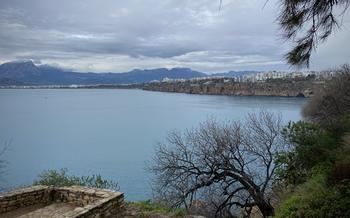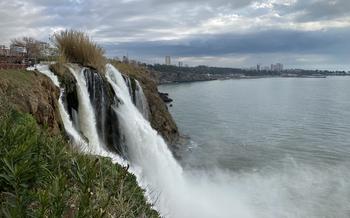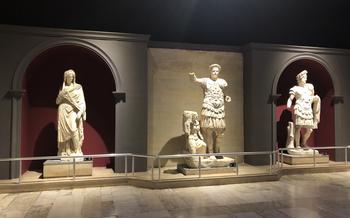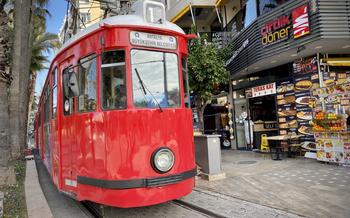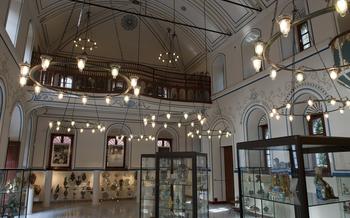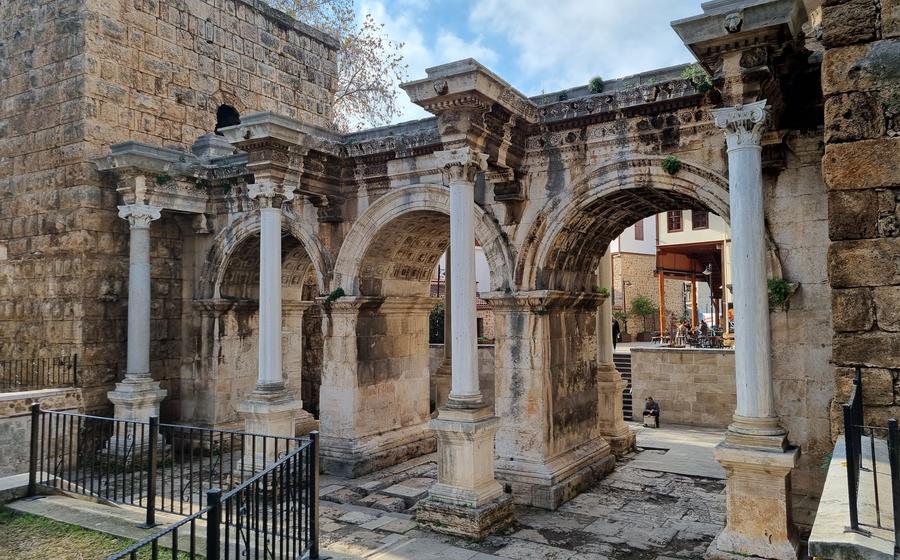
Hadrian's Gate
- Hadrian's Gate: A Majestic Symbol of Antalya's History
- Location and Accessibility
- Historical Context and Background
- Architectural Details and Design
- Symbolism and Representation
- Restoration and Preservation Efforts
- Visiting the Gate: Tips and Practicalities
- Exploring the Surroundings
- Hadrian's Gate in Local Culture
- Off-the-Beaten-Path Experiences
- Tips for Photography Enthusiasts
- Hadrian's Gate in Literature and the Arts
- Hadrian's Gate as a Symbol of Unity
- Insider Tip: Secret Passageway
Hadrian's Gate: A Majestic Symbol of Antalya's History
In the heart of Antalya, Turkey, stands a testament to the city's rich history and enduring legacy: Hadrian's Gate. This monumental structure, built during the Roman Empire, serves as a majestic gateway to the old city, inviting visitors to explore the depths of its ancient past.
The gate holds immense historical significance, dating back to the 2nd century AD when the Roman Emperor Hadrian visited Antalya. In his honor, the gate was constructed as a ceremonial entrance, symbolizing the city's loyalty and reverence for the emperor. Its grand design and intricate carvings reflect the architectural prowess and artistic sensibilities of the Roman era.
Hadrian's Gate stands as a symbol of Antalya's heritage, representing the city's resilience and endurance throughout the centuries. It has witnessed the rise and fall of civilizations, serving as a silent observer of history's grand tapestry. Today, it remains an iconic landmark, a source of pride for the people of Antalya, and a reminder of the city's deep-rooted connection to its glorious past.
Location and Accessibility
Hadrian's Gate stands proudly in the heart of Antalya's Old City, also known as Kaleiçi. To reach this majestic landmark, simply follow Atatürk Boulevard, the main artery of the city, and turn onto Cumhuriyet Caddesi. The gate is situated at the end of this street, serving as a symbolic gateway to the historic district.
Transportation to Hadrian's Gate is convenient and accessible. Several bus lines, including the 07 and 38, have stops within walking distance. If you prefer the convenience of a taxi, they are readily available throughout the city and can drop you off right at the gate's entrance.
For those arriving by car, limited parking is available in the vicinity. However, it's important to note that the Old City is primarily pedestrianized, so finding a parking spot can be challenging. Consider utilizing public transportation or taxis to avoid the hassle of finding parking.
The best time to visit Hadrian's Gate is during the early morning or late afternoon when the lighting is optimal for photography and the crowds are smaller. This will allow you to fully appreciate the gate's architectural details and capture stunning shots without the distraction of throngs of tourists.
Historical Context and Background
Hadrian's Gate was constructed under the reign of the Roman Emperor Hadrian, who visited Antalya in 130 AD. The gate was built as a ceremonial entrance to the city, marking the official entry point for dignitaries and visitors. Its construction was part of a larger urban renewal project undertaken by Hadrian, who was known for his extensive building endeavors throughout the empire.
The dedication of the gate to Hadrian commemorated his visit and celebrated his contributions to the city. It served as a symbol of the Roman Empire's power and influence in the region. Over the centuries, the gate has witnessed numerous historical events and has been associated with various figures, including Byzantine emperors, Seljuk sultans, and Ottoman rulers, each leaving their mark on Antalya's rich history.
Architectural Details and Design
Hadrian's Gate stands as a testament to Roman engineering and architectural prowess. Constructed using local limestone, the gate boasts an impressive triple-arched structure, flanked by two smaller pedestrian arches. Each archway is adorned with intricate carvings and moldings, showcasing the skill and artistry of Roman craftsmen.
The gate's façade is further embellished with Corinthian columns, their fluted surfaces adding a touch of elegance and grandeur. Atop the columns, a series of decorative friezes depict various scenes and figures, offering a glimpse into the rich mythology and history of the Roman Empire.
The central arch, the largest and most ornate, features a prominent keystone depicting the head of the Roman god Jupiter. The smaller arches, though less elaborate, are equally impressive, showcasing the gate's symmetry and balance.
Hadrian's Gate shares similarities with other Roman gates, such as the Arch of Titus in Rome and the Arch of Trajan in Benevento. However, it stands out due to its unique design elements, including the triple-arched structure and the intricate carvings that adorn its façade.
Symbolism and Representation
Hadrian's Gate stands as a powerful symbol of Antalya's rich history and enduring connection to the Roman Empire. Its imposing presence evokes the city's ancient heritage and the grandeur of a bygone era. The gate represents the resilience and endurance of Antalya, having witnessed countless historical events and withstood the test of time. For the people of Antalya, Hadrian's Gate holds immense cultural and historical significance, serving as a tangible reminder of their city's deep-rooted past. Its integration into modern-day city life further underscores its enduring relevance and importance, as it continues to captivate visitors and locals alike with its timeless beauty and historical charm.
Restoration and Preservation Efforts
Hadrian's Gate has undergone several restoration and conservation projects to maintain its historical integrity and preserve its grandeur for future generations. Recognizing the gate's cultural significance, local authorities and international organizations have collaborated to protect this architectural treasure.
One of the most significant restoration projects was undertaken in the early 20th century, focusing on stabilizing the gate's structure and repairing damaged elements. This included reinforcing the foundation, repairing cracks and fissures, and restoring the intricate carvings and friezes.
In recent years, ongoing conservation efforts have focused on preserving the gate's original materials and features. Experts have employed specialized techniques to clean and treat the stone surfaces, preventing further deterioration and maintaining the gate's authenticity.
Despite these efforts, challenges remain in preserving the gate's original features. The constant exposure to weather elements, pollution, and the natural aging process pose ongoing threats to the gate's integrity. However, the dedication of conservators and the support of the local community ensure that Hadrian's Gate continues to stand as a testament to Antalya's rich history and cultural heritage.
Visiting the Gate: Tips and Practicalities
Hadrian's Gate stands as a testament to Antalya's rich history, welcoming visitors to explore its grandeur. The gate is open to the public, offering an immersive experience into the past. Admission is usually free, allowing travelers to marvel at this architectural masterpiece without any financial constraints. Guided tours are available for those seeking a deeper understanding of the gate's historical significance and architectural features. Additionally, audio guides provide a self-guided tour option for visitors who prefer to explore at their own pace. Accessibility features, such as ramps and designated parking spaces, ensure that visitors of all abilities can enjoy the gate's wonders. To capture the gate's majesty in photographs, visitors are encouraged to bring their cameras and tripods. The interplay of light and shadow creates stunning photo opportunities, especially during the golden hours of sunrise and sunset.
Exploring the Surroundings
Hadrian's Gate stands as a testament to Antalya's rich history, but its surroundings are equally captivating. Just a stone's throw away, visitors can immerse themselves in a labyrinth of narrow, cobblestone streets lined with charming shops, cafes, and restaurants. The Old City, known as Kaleiçi, is a treasure trove of historical wonders, including the Antalya Museum, which houses an impressive collection of artifacts from the region's past. For those seeking a unique perspective, a stroll along the scenic marina offers breathtaking views of the harbor and the sparkling Mediterranean Sea.
Beyond the immediate vicinity of Hadrian's Gate, Antalya unveils a plethora of attractions. The Düden Waterfalls, a cascade of cascading waters surrounded by lush greenery, is a sight to behold. History buffs can delve into the past at the Antalya Archaeological Museum, which houses a vast collection of ancient relics. For a taste of local culture, the Old Bazaar, with its vibrant atmosphere and colorful stalls, is a must-visit.
To fully experience Antalya's diverse offerings, consider crafting a comprehensive itinerary. Dedicate a morning to exploring Hadrian's Gate and its surroundings, savoring the historical charm of the Old City and indulging in the local cuisine. In the afternoon, venture further afield to discover the Düden Waterfalls and the Antalya Archaeological Museum. As the sun begins to set, immerse yourself in the vibrant energy of the Old Bazaar, where you can haggle for souvenirs and savor the tantalizing aromas of traditional Turkish cuisine.
Hadrian's Gate in Local Culture
Hadrian's Gate holds a special place in the hearts of Antalya's residents, who regard it as a symbol of their city's rich history and cultural heritage. The gate has become an integral part of local life and traditions, playing a significant role in festivals, celebrations, and folklore.
During the annual Antalya Festival, the gate serves as a vibrant backdrop for colorful parades, traditional music performances, and lively dancing. Locals and tourists alike gather around the gate to witness the spectacular festivities, which pay homage to Antalya's unique cultural heritage.
The gate is also deeply embedded in local folklore and legends. According to one popular tale, the gate possesses magical powers and can grant wishes to those who pass through it with a pure heart. This belief has transformed the gate into a popular destination for locals seeking good fortune and blessings.
Moreover, Hadrian's Gate serves as a beloved gathering place and meeting point for the people of Antalya. Whether it's friends catching up over coffee, families enjoying a leisurely stroll, or couples taking a romantic evening walk, the gate provides a charming and historic backdrop for social interactions.
Off-the-Beaten-Path Experiences
Beyond the main attractions, Hadrian's Gate offers unique opportunities for exploration and discovery. Venture into the surrounding neighborhoods, where hidden corners and lesser-known aspects of the gate await. Explore the alleyways and discover unique perspectives and viewpoints that reveal the gate's hidden stories and secrets. Immerse yourself in the local culture by chatting with friendly residents and shopkeepers, who may share anecdotes and legends associated with the gate. Embrace the opportunity to capture unique and memorable shots of the gate by experimenting with different angles and perspectives. Unveiling the gate's hidden gems will provide a deeper understanding and appreciation of its significance and allure.
Tips for Photography Enthusiasts
Prepare to capture the majesty of Hadrian's Gate with your camera. To capture the gate's grandeur, choose a wide-angle lens to fit the entire structure into your frame. Experiment with different angles and perspectives to create dynamic shots. Position yourself directly in front for a classic view or explore side angles to highlight its intricate details. For optimal lighting, visit during the golden hours of sunrise or sunset when the warm hues enhance the gate's architectural features. Use a tripod to stabilize your camera and achieve sharp, blur-free images. Embrace creative techniques like long exposure to capture the movement of clouds or people, adding a sense of dynamism to your photographs. Don't forget to play with different shutter speeds and apertures to control the depth of field and create striking compositions.
Hadrian's Gate in Literature and the Arts
Hadrian's Gate has captured the imagination of writers, poets, and artists throughout history. In literature, the gate has been mentioned in novels, short stories, and travelogues, serving as a symbol of Antalya's rich history and cultural heritage. Poets have penned verses that evoke the grandeur and resilience of the gate, immortalizing its beauty in words.
In the realm of visual arts, Hadrian's Gate has been a popular subject for painters and sculptors. Paintings depicting the gate often capture its architectural details and its integration into the cityscape. Sculptors have created works that symbolize the gate's endurance and its representation of Antalya's spirit.
The gate's cultural significance extends beyond literature and visual arts. It has also found its way into music and theater. Composers have incorporated the gate into their musical compositions, evoking its historical significance and its role as a symbol of unity and resilience. Theatrical productions have featured the gate as a backdrop, creating a powerful and immersive experience for audiences.
Hadrian's Gate continues to inspire creative minds, serving as a muse for writers, poets, artists, and musicians alike. Its presence in literature and the arts ensures that its legacy will live on for generations to come.
Hadrian's Gate as a Symbol of Unity
Hadrian's Gate stands as a testament to the rich history and cultural tapestry of Antalya. As a city that has been shaped by diverse influences throughout the centuries, Hadrian's Gate embodies the spirit of unity and coexistence. The gate represents the city's openness and its welcoming nature, embracing visitors from around the world with its architectural grandeur and historical significance. Through its enduring presence, Hadrian's Gate serves as a reminder of the power of diversity and the importance of fostering understanding and harmony among people of different cultures and backgrounds. Whether admiring its intricate carvings, exploring its hidden corners, or simply marveling at its majesty, Hadrian's Gate invites visitors to reflect on the interconnectedness of humanity and the shared heritage that binds us together.
Insider Tip: Secret Passageway
For those seeking a unique and unforgettable experience, Hadrian's Gate holds a hidden gem—a secret passageway leading to the upper levels of the gate. This exclusive opportunity offers breathtaking panoramic views of Antalya and the surrounding landscapes. Access to the passageway is limited and requires special permission, but for the adventurous and curious, it's an experience not to be missed. Imagine standing atop the gate, marveling at the city's vibrant tapestry and the azure waters of the Mediterranean Sea stretching out before you. It's a moment of pure awe and wonder, a chance to connect with history and appreciate the beauty of Antalya from a privileged perspective.
